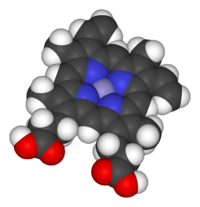
Photo from wikipedia
Recombinant production of heme proteins in Escherichia coli is often limited by the availability of heme in the host. Therefore, several methods, including the reconstitution of heme proteins after production… Click to show full abstract
Recombinant production of heme proteins in Escherichia coli is often limited by the availability of heme in the host. Therefore, several methods, including the reconstitution of heme proteins after production but prior to purification or the HPEX system, conferring the ability to take up external heme have been developed and used in the past. Here we describe the use of the apathogenic E. coli strain Nissle 1917 (EcN) as a suitable host for the recombinant production of heme proteins. EcN has an advantage over commonly used lab strains in that it is able to take up heme from the environment through the heme receptor ChuA. Expression of several heme proteins from different prokaryotic sources led to high yield and quantitative incorporation of the cofactor when heme was supplied in the growth medium. Comparative UV-vis and resonance Raman measurements revealed that the method employed has significant influence on heme coordination with the EcN system representing the most native situation. Therefore, the use of EcN as a host for recombinant heme protein production represents an inexpensive and straightforward method to facilitate further investigations of structure and function.
Journal Title: Biochemistry
Year Published: 2018
Link to full text (if available)
Share on Social Media: Sign Up to like & get
recommendations!